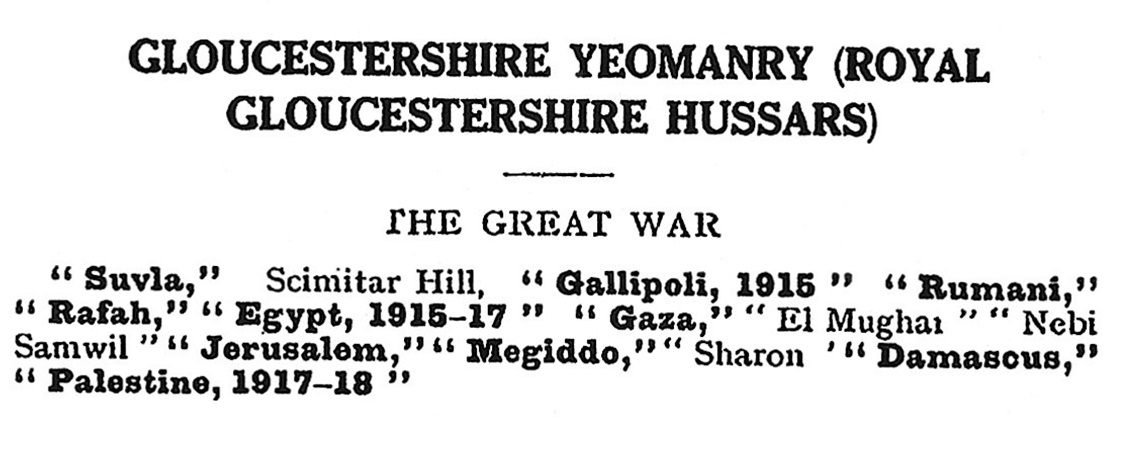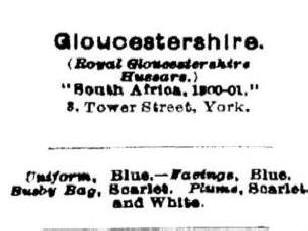|
A detailed
history of the Regiment can be viewed
here and
here.
At the outbreak of
Great War, the Regimental Headquarters and
“A” Squadron were based at The Barracks in Gloucester; “B” Squadron at
Stroud; “C” at Newport; “D” at Bristol. The Regiment was under
command of 1st South Midland Brigade, 1st Mounted Division.
From 4th August 1914, many
members of the Regiment volunteered for overseas Imperial Service.
Therefore, in August and September of 1914, like most TF units, the
Regiment was split into a 1st Line unit (liable
for overseas service) and a 2nd Line unit (home service for those
unable or unwilling to serve overseas). Later in early
1915, a 3rd
Line unit was formed to act as a depot and reserve, providing trained
replacements for the 1st and 2nd Line units.
1st/1st Royal Gloucestershire Hussars.
On mobilisation, the unit was moved to its operational location, for
Coastal Defence duties, at Bury St Edmunds.
On 31st August 1914 the Regiment was moved, with the 1st South Midland Brigade
to Newbury and then transferred to 2nd Mounted Division before moving
again in November 1914 to King's Lynn. In April 1915 the
Division was warned for overseas service in Egypt, embarking at
Avonmouth and arriving at Alexandria on 24th April 1915. The
Division was deployed for Suez Canal defence duties and on 10th August
1915 was reorganised and dismounted, preparing for service in Gallipoli.
Like all Yeomanry Regiments in the Division, it left a Squadron in Egypt
to take care of the horses. The Division sailed for Mudros
on 13th August, arriving there on the 17th August and immediately sailed
for Suvla Bay, arriving at "A" Beach late that evening. The
Regiment was moved to reserve positions at Lala Baba and on 21st August
it advanced to Chocolate Hill under heavy fire and took part in the
attacks on Chocolate Hill and Hill 112. Due to battle
casualties and other wastage during August 1915, the Division had to be
reorganised. On 4th September 1915, the 1st Composite
Mounted Brigade was formed from the 1st, 2nd and 5th Mounted Brigades,
and the 2nd Composite Mounted Brigade from the 3rd and 4th Mounted
Brigades. Each dismounted Brigade formed a Battalion sized unit, for
example, 1st South Midland Regiment
(Warwickshire, Gloucestershire and Worcestershire Yeomanry). The
1st South Midland Regiment continued operations in trench warfare
activities in the Green Hill and Chocolate Hill sectors until being
evacuated to Mudros on 31st October 1915, with a strength of only 81 men
of all ranks. The Regiment was finally withdrawn from
Gallipoli in December 1915 and returned to Egypt for reorganisation,
refitting and remounting. In January 1916 the Brigade
became an independent command and was retitled as 5th Mounted Brigade
and served as Corps Troops in Egypt before being transferred to the
Imperial Mounted Division (later renamed the Australian Mounted Division
on 30th June 1917) in February 1917 for operations first in the Sinai
and then in the Palestine Campaign. With this Division, the
Regiment it took part in the Third Battle of Gaza including
the Capture of Beersheba and the Battle of Mughar Ridge. It also
resisted the Turkish counter-attacks in the Turkish Defence of
Jerusalem. Three of the Brigade's squadrons took part in the Charge at
Huj, the last British cavalry charge against enemy guns.
By an Egyptian Expeditionary Force GHQ Order of 12 April 1918, the
mounted troops of the EEF were reorganised when Indian Army units
arrived in-theatre. On 24th April 1918, the 2nd Mounted
Division was formed on the Indian Army Establishment and the 5th Mounted
Brigade was assigned to it. On 24th April 1918, the 5th
Mounted Brigade was merged with elements of the 3rd (Ambala) Cavalry
Brigade (Indian Army) with the Royal Gloucestershire
Hussars remaining with the Brigade whilst other UK Yeomanry Regiments
were posted away to other operational organisations. On 22nd
July 1918, the 2nd Mounted Division was renumbered as the 5th Cavalry
Division and the Brigade as the 13th Cavalry Brigade.
The Brigade remained with 5th Cavalry Division for the rest of the war,
taking part in the Affair of Abu Tellul, Battle of Megiddo, Capture of
Damascus, and Occupation of Aleppo. After the Armistice of
Mudros, the Brigade remained with 5th Cavalry Division in Palestine as
part of the Occupation Force. However, demobilization
swiftly began with the 13th Cavalry Brigade being disbanded in April
1920.
2nd/1st Royal Gloucestershire
Hussars. Formed September 1914 and joined 2nd/1st South
Midland Mounted Brigade at Cirencester. The unit moved to Norfolk
joining 2nd/2nd Mounted Division in June 1915. Became a
Cyclist unit in March 1916 and joined 8th Cyclist Brigade, 2nd Cyclist
Division for Coastal Duties initially in Kent and then in the Ipswich area. In November 1916,
the unit joined the 12th
(Gloucestershire and Worcestershire Yeomanry) Cyclist Regiment at Ipswich,
part of 4th Cyclist
Brigade. By April 1918, unit has resumed its identity and
role as 2/1st Royal
Gloucestershire Hussars and served
in Dublin to the end of the war.
3rd/1st
Royal Gloucestershire Hussars. Formed at Gloucester in early 1915 as a Third Line
depot, reserve and training unit supplying trained reinforcements for
the 1/1st and 2/1st units, and for other Home Defence duties.
Joined the 4th (Reserve) Cavalry Regiment at Tidworth in April 1916
before being absorbed by the 5th (Reserve) Cavalry Regiment at Tidworth in 1917.
Great War Regimental Battle Honours
On 4th September 1922 a Special Army Order was issued by the War
Office approving the award of Battle Honours to Regiments and
Corps of the British Army. This Order also directed
that Honours given would follow, in the Army List any that had
previously been earned and should be headed by "The Great War"
and the number of Battalions taking part. Thus,
Honours earned individually by Regular, Militia (or Special
Reserve), Territorial and Service Battalions were placed on one
list.
Throughout 1924 a number of Army Orders
were issued giving the Honours awarded to each Regiment.
However, in the following year these lists were cancelled under
Army Order 55 of February 1925, and in their place a "final
list" issued. This list contained Honours that had
been approved, and directed that "no further submissions
concerning the Great War Battle Honours will be made"
The sheer scale of the Great War led to
a previously unheard of number of honours being awarded and it
was simply impractical to emblazon every one of them on the
Regimental Colour. In September 1922 it was ordered
that Regiments should select up to 10 Honours to be emblazoned
on their Regimental Colours along with previous awards, up to a
total of 24. This led to a storm of protest, since
many Regiments would have had to remove previous Honours.
The order was therefore amended in the following December, to
allow each Regiment to select up to 10 Honours to be emblazoned
on its King's/Queen's Colour, Honours from other conflicts
continuing to be displayed on the Regimental Colour.
Honours
in bold below are emblazoned on
the King's/Queen's
Colours.
The 14 Great War Battle Honours awarded to the
Gloucestershire Yeomanry are listed below (as published in War Office
letter 20/Gen. No./5034 dated 27th February 1925, issued with
Army Order 55/1925).

|

